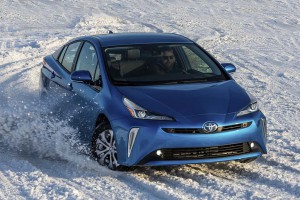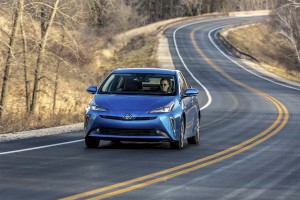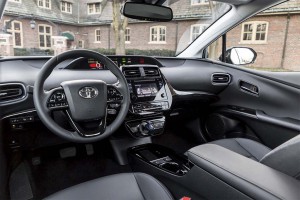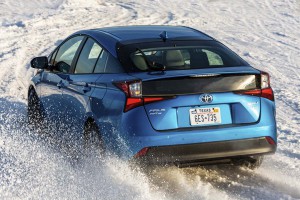
The 2019 Toyota Prius comes in an all-wheel drive model that should stimulate sales in cold-weather environs.
When the original Toyota Prius first rolled into U.S. showrooms nearly 20 years ago it promised to transform the auto industry, delivering the sort of fuel economy numbers that seemed all but impossible at the time. Never mind the hatchback’s quirky styling – or perhaps because of it – the Prius quickly developed a broad and loyal following, at its peak becoming the best-selling nameplate in the huge California market.
Sales have been in a slump for several years, however, and a variety of factors, including cheap gas and some odd design choices on the fourth-generation Prius deserve much of the blame, along with the fact that the Toyota hybrid now has lots more competition.
Yet, even as some of its key competitors are walking away from the passenger car market, Toyota is doubling down and betting it can breathe new life back into Prius. The 2019 model-year brings some modest, if much-needed design tweaks, as well as the introduction of a new electric all-wheel-drive system that, the automaker expects will account for about a quarter of the nameplate’s sales going forward by enhancing the hatchback’s appeal in Snowbelt climes.
To get a new look at the 2019 Toyota Prius and test out its AWD-e package we headed up to Kohler, Wisconsin, for a first drive. Known by many locals as “Colder” Wisconsin, it seemed the perfect place to experience the new system – but while storms were socking in the southern half of the country, it proved unexpectedly balmy, as least by Midwest standards, forcing Toyota to make some of its own snow along a short off-road course.
But before we get into what it’s like to drive, let’s start with a look at the 2019 Toyota Prius. The gen-4 model stuck to the original Toyota formula emphasizing quirky design elements that also happened to improve aerodynamics. But, for many potential buyers, the automaker pushed things a little too far and, with the 2019 update, has toned things down a bit.
(Sales sliding, Toyota rethinking plans for Prius. Click Here for the story.)
There’s a new fascia up front, with smaller headlamps – which are now adaptive on upper trim levels – and cleaner lines. The AWD-e model gets LED lamps, as well. The back end also has been cleaned up a bit, with more horizontal taillamps that now more closely resemble those on the plug-in hybrid Toyota Prius Prime. There are also new wheel covers, with a choice of 15 or 17-inch wheels on various trim packages.
There’ve been more notable changes inside, starting with the elimination of the bright white plastic trim that was already out of date when the gen-4 Prius hit market. The 2019 model has a more refined cabin, with more modern materials and improved textures. There’s also a new 11.6-inch touchscreen on high-line models. Not quite as big as the display on the Tesla Model 3, but that’s just fine with us as there are also hard controls to operate a number of critical vehicle functions. That includes easier to find switches for the seat heaters – something likely to please anyone buying the Prius AWDe model.
Add more USB ports and seatback pockets for rear seat occupants and Toyota has addressed some key concerns. It did not do anything to weaken the Prius hatchback’s strengths, including a roomy cabin and great visibility.
Another plus: all versions of the 2019 Prius now come standard with the Toyota Safety Sense system which includes such features as forward collision warning with automatic emergency braking, lane departure warning, active cruise control and auto high beams.
But the big tech news for ’19 is the introduction of the hybrid’s first-ever all-wheel-drive system. The optional AWD-e package – which is offered on two trim levels for around $1,400 – introduces a compact magnet-less motor driving the rear axle. It adds a modest 7.1 horsepower and 40.6 pound-feet of torque on top of the 121 hp and 105 pound-feet made up front by Prius’s 1.8-liter inline-four gas engine and twin electric motor.

The fourth-generation Prius gets a slew of technology updates that make it safer and perform better than ever.
Because of the peculiarities of electric drive, Toyota officials wouldn’t offer revised power ratings for the Prius AWD-e. One reason is that the rear motor isn’t operating most of the time. It normally kicks in at launch but then shuts down when the car hits 6 mph. If traction is poor, it can continue to operate or come back in at speeds up to 43 mph.
Toyota was also cautious about offering revised performance numbers. The best we could discern is that the car may have just a wee bit more oomph on launch but will be no faster to 60 because of the added weight. Depending upon trim level, that ranges from an extra 140 to 175 pounds.
Where things matter is when you find yourself on low traction surfaces, like the steep hill Toyota covered with artificial snow. The conventional Prius would be hard-pressed to make it up that rise, even with a running start. The AWD-e model, however, retained its poise, even after coming to a complete stop before we crested the hill.
(Click Here for more about the Prius AWD-e)
We had the chance to more directly compare the front-drive and all-wheel-drive models on a snowy slalom course and found it far less likely to lose its composure, even under overly aggressive steering wheel inputs.
We’d like to say we could find a difference on public roads but not-so-cold Kohler really didn’t offer enough of a comparison this past week. That said, even our brief experience on those off-road runs suggested Toyota engineers have done a good job delivering enough enhancements to the Prius driveline to make the car a viable contender in snowy parts of the country.
That said, we were curious why the automaker didn’t push things further, perhaps by allowing the AWD-e system to remain engaged for longer periods and at higher speeds, and even allowing it to introduce some torque vectoring to improve cornering on skid-prone roads.

The new Prius gets an 11.3-inch touchscreen console to control many of the systems of the new Prius.
Toyota engineers felt that other onboard “nanny” systems, like traction control and electronic stability control do a good enough job under most conditions. Meanwhile, two other factors had to be considered:
- Fuel economy, for one thing, the 2019 Toyota Prius AWD-e delivering a combined rating of 50 mpg, just two less than the front-drive model;
- Then there’s cost. Toyota has always positioned Prius as an “affordable hybrid,” and the automaker didn’t want to drift away from that now, especially when low fuel prices make it harder to justify a hybrid.
And there, the 2019 Toyota Prius continues to hit the mark. While it’s no longer the least expensive hybrid on the market, it’s still a reasonably solid bargain considering you’ll have to load it way up to get much above $30,000.
The base L Eco – which manages to deliver a combined 56 mpg – starts at just $23,770. The top-end Limited begins at $32,200. In between are the LE, at $24,980 and the XLE at $27,820. Those two are the only trims featuring AWD-e, at $26,380 and $28,820, respectively.
(To see more about the new 2020 Toyota Corolla, Click Here.)
With the design tweaks and new AWD-e system, Toyota has made some modest but much-needed improvements to the 2019 Prius. The reality of the market suggests that the hybrid will likely never reach its former sales numbers but even in this SUV-centric market it could rebuild some momentum this coming year.

